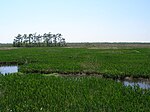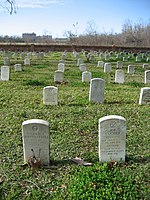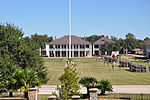Fazendeville, Louisiana
1964 disestablishments in LouisianaForcibly depopulated communities in the United StatesGhost towns in St. Bernard Parish, LouisianaHistory of LouisianaPopulated places disestablished in 1964

Fazendeville was a small, historic, African American community in St. Bernard Parish, Louisiana, United States. Located near the Freedmen's Cemetery in the parish, this village was razed during the 1960s as part of an expansion of the Chalmette National Battlefield in the Jean Lafitte National Historic Park and Preserve.It was known to residents who lived there as "The Village."A significant percentage of the village's displaced residents resettled in New Orleans' Ninth Ward.
Excerpt from the Wikipedia article Fazendeville, Louisiana (License: CC BY-SA 3.0, Authors, Images).Fazendeville, Louisiana
Jean Lafitte Parkway,
Geographical coordinates (GPS) Address Website Nearby Places Show on map
Geographical coordinates (GPS)
| Latitude | Longitude |
|---|---|
| N 29.941388888889 ° | E -89.991388888889 ° |
Address
Chalmette Battlefield
Jean Lafitte Parkway
70043
Louisiana, United States
Open on Google Maps








